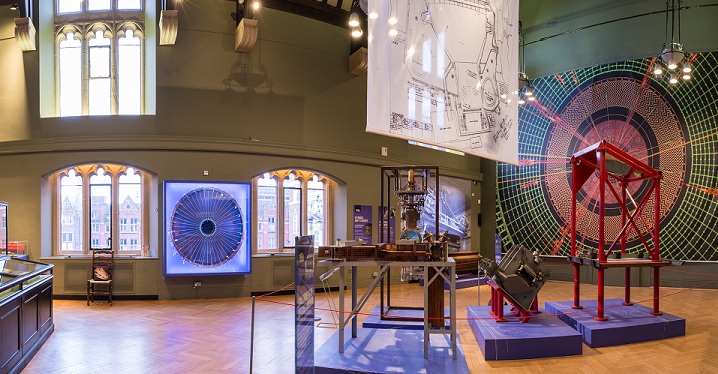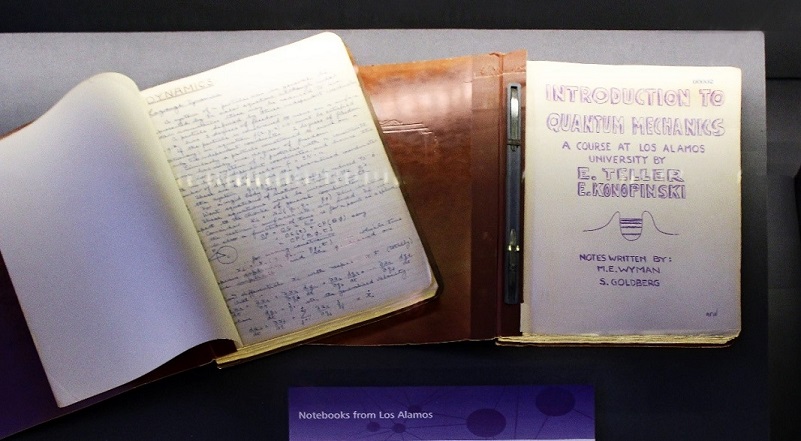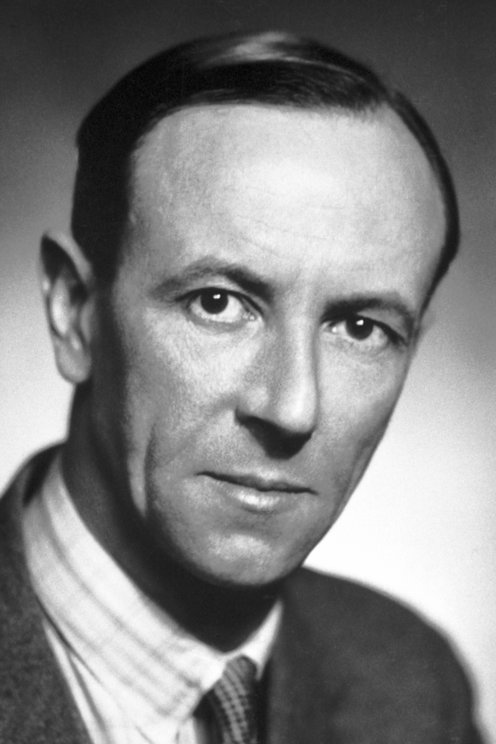The Los Alamos Notebooks (and the stories they could tell)
Posted on: 4 August 2023 by Leonie Sedman, Curator of Heritage and Collections Care in 2023

During the period between February 2014 and May 2018, when our Particle Physics exhibition was in the Tate Hall Museum, the VGM had around 200,000 visitors – so it’s fair to assume that a number of them might have seen the Christopher Nolan film ‘Oppenheimer’ and wondered why they didn’t recognise any of the Liverpool names amongst the characters in the film.
People might be especially surprised at the absence of James Chadwick – considering his Nobel-Prize winning discovery of the Neutron opened the door for the research that led to the Manhattan Project - and that he worked very closely with General Leslie Groves throughout the project. But it’s important to remember that the film is a biopic, and as such only includes people whose presence is relevant to the telling of Oppenheimer’s personal story.
Interestingly, the film does pay close attention to one physicist linked to the exhibits in our exhibition:

Above: The notebooks entitled ‘Introduction to Quantum Mechanics, A course at Los Alamos University’ by Edward Teller and Emil Konopinski’.
Teller and Konopinski’s notes were part of a set which included ‘Nuclear Physics’, ‘Statistical Mechanics’ and ‘Electromagnetic Theory’ - all by different authors (examples of these are in the American Institute of Physics, Niels Bohr Library & Archives) produced in order to bring the disparate scientists involved in the project - all of whom were at the top of their field - up to speed with the very latest relevant research. These particular notebooks belonged to Jimmy Hughes, who remained in Liverpool whilst working as part of Chadwick’s team on the Manhattan Project.
Teller’s later work would see him referred to as ‘The Father of the Hydrogen Bomb’. Following his testimony at the Oppenheimer hearing (seen in the film), Teller’s friendship with Oppenheimer never recovered and his personal reputation amongst many other scientists also suffered, but his later scientific work successfully led to the creation of the Hydrogen Bomb, deemed so powerful that - in theory - it must never be used and ostensibly acts as the ultimate deterrent against any future use of nuclear weapons.
At the beginning of the Manhattan Project, the scientists and politicians believed that they were in a race with Germany to produce atomic weapons, but by 1945 this was known not to be the case, and the expressed reasoning had now changed - for the bomb to be a way of bringing the war in the Pacific to an end (although Rotblat later wrote that Groves had admitted that he was already preparing for the post-war Soviet threat). Historians still argue over the validity of this argument, and photographs from Hiroshima and Nagasaki will always retain the power to shock.
Although the bombs dropped on Hiroshima and Nagasaki on the 6th and 9th August 1945, caused fewer initial deaths than the conventional firebombing of Tokyo on the night of 9th March 1945, the - previously unimaginable - horrific nature of the devastation and lasting impact of the human and environmental destruction caused at Hiroshima and Nagasaki created an ethical and moral argument that continues to this day.

The shadow of a victim of the Hiroshima bomb. Photograph taken by US forces on 20 November 1945
In July 1945, 70 scientists working for the Manhattan Project signed a petition addressed to President Truman, attempting to persuade him not to use the atomic bomb before adequately warning Japan, but the President did not see it until after the bombs had been used. Again, researchers still argue over whether the Japanese would have surrendered without the use of the atomic bombs.
Joseph Rotblat, James Chadwick’s colleague from Liverpool resigned from the Manhattan Project in late 1944 upon learning that the Germans were not going to be able to complete their bomb. He spent the rest of his career concentrating on medical physics, and in 1995 was awarded the Nobel Peace Prize for his work on the establishment in 1957 of the Pugwash Conferences on Science and World Affairs which ‘seeks a world free of nuclear weapons and other weapons of mass destruction’ and urges ‘Remember your Humanity’. In 1963, the campaign of Rotblat and others led to the Partial Nuclear Test Ban Treaty which established an important precedent for future arms control.
After the war, Rotblat wrote of his inability to understand the other scientists who continued to work on the development of weapons of mass destruction. It is interesting to contemplate the question – what would you do if you were offered unlimited funding to carry out your research and secure employment to do so for as long as you wanted? Rotblat was noticeable by his rejection of such opportunities on moral grounds.

Above: James Chadwick, in 1941 - "I wish I could tell you that the bomb is not going to work, but I am 90% sure that it will".
Chadwick is said to have been of the opinion that his work was the science and it was up to the politicians to decide how to use it, although this quote from April 1969 shows the toll that the responsibility took on him ‘I remember the spring of 1941 to this day. I realised then that a nuclear bomb was not only possible – it was inevitable… and I had then to start taking sleeping pills. It was the only remedy, I’ve never stopped since then’.
Oppenheimer’s infamous quote ‘Now I am become Death, the Destroyer of Worlds’ – taken from the Hindu sacred text The Bhagavad Gita – is part of a larger and much more complex story in which a warrior learns a higher philosophy that will enable him to carry out his duties as a warrior despite his personal concerns. We will never know if this larger meaning was in Oppenheimer’s mind.
References:
https://www.nobelprize.org/prizes/peace/1995/rotblat/facts/
https://pugwash.org/history/joseph-rotblat/
https://www.aip.org/history-programs/niels-bohr-library/oral-histories/3974-1
https://www.britannica.com/biography/James-Chadwick
Keywords: Oppenheimer, Edward Teller, Manhattan Project, Hiroshima, James Chadwick, Nagasaki, Joseph Rotblat, James Chadwick.